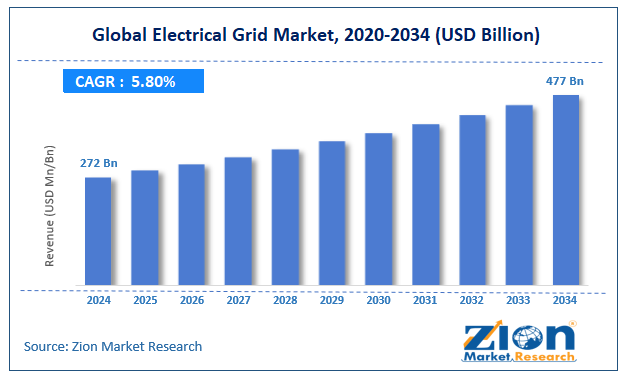Electrical Grid Market Size, Share, Trends, Growth and Forecast 2034

Electrical Grid Market By Source (Natural Gas, Coal, Hydro, Renewables, and Others), By Application (Generation, Transmission, and Distribution), and By Region - Global and Regional Industry Overview, Market Intelligence, Comprehensive Analysis, Historical Data, and Forecasts 2025 - 2034
| Market Size in 2024 | Market Forecast in 2034 | CAGR (in %) | Base Year |
|---|---|---|---|
| USD 272 Billion | USD 477 Billion | 5.8% | 2024 |
Electrical Grid Industry Prospective:
The global electrical grid market size was worth around USD 272 billion in 2024 and is predicted to grow to around USD 477 billion by 2034, with a compound annual growth rate (CAGR) of roughly 5.8% between 2025 and 2034.
Electrical Grid Market: Overview
An interconnected system for delivering electricity from producers to consumers is known as an electrical grid or electricity network. Power plants, electrical substations for stepping up or lowering voltage, transmission systems for moving electricity across long distances, and distribution systems for distributing electricity to consumers make up electrical grids. The voltage is stepped down once more to the necessary service voltage in that final stage.
Usually, power plants are situated far from densely inhabited regions and near energy sources. Electrical grids can span entire nations or continents and come in a variety of sizes.
Microgrids, wide-area synchronous grids, and supergrids range in size from small to large. The power grid, which includes the transmission and distribution network, is a component of the electrical delivery system.
Key Insights
- As per the analysis shared by our research analyst, the global electrical grid market is estimated to grow annually at a CAGR of around 5.8% over the forecast period (2025-2034).
- In terms of revenue, the global electrical grid market size was valued at around USD 272 billion in 2024 and is projected to reach USD 477 billion by 2034.
- The growing investment in renewable energy is expected to drive the electrical grid market over the forecast period.
- Based on the source, the renewables segment is expected to hold the largest market share over the forecast period.
- Based on its application, the generation segment is expected to dominate the market expansion over the projected period.
- Based on region, North America is expected to dominate the market during the forecast period.
Electrical Grid Market: Growth Drivers
Increasing electricity demand drives market growth
Growing global demand for power is one of the primary elements driving the expansion of the electrical grid market. Several factors are driving this growing demand that also affect grid renovation, growth, and new technology investment.
Particularly in emerging countries, fast urbanization is driving the increasing use of electricity in homes and businesses. Reliable, high-capacity grid architecture is needed in data centers, manufacturing facilities, and expanding industries as well.
Moreover, several countries are moving to hydro, wind, and solar energy, resulting in demands for advanced grid architecture for the distribution and storage of energy. Smart grids and battery storage systems are being brought in to balance the intermittent supply of renewable energy.
For instance, according to a report published by the IEA, the world's electricity consumption will increase at the quickest rate in the recent past, reaching about 4% per year through 2027 as power demand increases across the economy.
Electrical Grid Market: Restraints
High initial investment & maintenance costs hinder market growth
An important obstacle to electrical grid industry expansion, particularly in developing nations, is the high upfront and ongoing expenditures of electrical grid infrastructure. The complexity of constructing, modernizing, and maintaining grid networks—which include transmission lines, substations, and smart grid technologies—is the reason for these expenses.
A large amount of capital is needed to build new transmission and distribution lines. The high cost of labor, materials (steel, aluminum, and copper), and land acquisition raises overall costs.
New solutions for grid stabilization are also necessary for grid upgrades that accommodate hydroelectric, wind, and solar power. Batteries and pumped hydro storage are examples of energy storage devices that raise capital costs.
Electrical Grid Market: Opportunities
Growing launch of innovative solutions offers a lucrative opportunity for market growth
The increasing launch of innovative solutions in the electrical grid sector offers a lucrative opportunity for revenue growth over the analysis period.
For instance, Siemens Smart Infrastructure has developed highly scalable Internet-of-things (IoT) software as a service to transform electricity infrastructure. Designed by Siemens Smart Infrastructure, Electrification X is the most recent SaaS and IoT product from Siemens Xcelerator. Building X, a scalable and digital building platform, was the first product that Siemens Xcelerator debuted in 2022.
Then, unveiled in February 2024, was Siemens' innovative grid management system, Gridscale X. With Electrification X, which now completes the trio, Siemens' commitment to innovative technologies in the electrification sector is further shown.
Based on highly scalable cloud services, Electrification X is meant to automate, optimize, and manage the intricate electrification infrastructure of utility, commercial, and industrial customers. This will reduce CO2 emissions and save costs while increasing performance and efficiency.
Electrical Grid Market: Challenges
Complexity in grid modernization poses a major challenge to market expansion
Changing from conventional to modern smart grids is a complex process requiring advanced technological integration, regulatory compliance, and infrastructure development. While modernizing increases reliability, effectiveness, and the use of renewable energy, governments and utilities find great difficulties in the complexity of the process.
Many of the present systems, for instance, are based on outdated infrastructure spanning decades that is incompatible with smart technologies.
Upgrading old substations, transformers, and control systems while maintaining their operational state is somewhat challenging. Thus, the complexity of grid modernization poses a major challenge to the electrical grid industry.
Electrical Grid Market: Report Scope
| Report Attributes | Report Details |
|---|---|
| Report Name | Electrical Grid Market |
| Market Size in 2024 | USD 272 Billion |
| Market Forecast in 2034 | USD 477 Billion |
| Growth Rate | CAGR of 5.8% |
| Number of Pages | 213 |
| Key Companies Covered | Itron Inc., Schneider Electric SE, Siemens AG, Mitsubishi Electric Corporation, National Grid, ABB Ltd., NextEra Energy Inc., General Electric Company, Eaton Corporation PLC, Toshiba Corporation, and others. |
| Segments Covered | By Source, By Application, and By Region |
| Regions Covered | North America, Europe, Asia Pacific (APAC), Latin America, Middle East, and Africa (MEA) |
| Base Year | 2024 |
| Historical Year | 2019 to 2023 |
| Forecast Year | 2025 - 2034 |
| Customization Scope | Avail customized purchase options to meet your exact research needs. Request For Customization |
Electrical Grid Market: Segmentation
The global electrical grid industry is segmented based on source, application, and region.
Based on the source, the global electrical grid market is bifurcated into natural gas, coal, hydro, renewables, and others. The renewables segment is expected to hold the largest market share over the forecast period. The growing investment in renewable energy is what influences the segment expansion. For instance, according to the IRENA, with 585 GW of capacity additions, renewables accounted for over 90% of total power expansion globally in 2024.
Based on application, the global electrical grid industry is bifurcated into generation, transmission, and distribution. The generation segment is expected to dominate the market expansion over the projected period. The segment expansion is driven by the increasing electricity demand.
Electrical Grid Market: Regional Analysis
North America dominates the market over the projected period
North America is expected to dominate the global electrical grid market. To provide a cleaner, more sustainable power system, the region's electrical grid market is distinguished by its emphasis on updating outdated infrastructure and implementing renewable energy sources.
To improve grid stability and more effectively handle the rising power demand, the United States and Canada are implementing cutting-edge technologies in demand response programs, energy storage, and smart grids.
On the other hand, the Asia Pacific is expected to grow at the fastest rate over the projected period. The rapid industrialization and urbanization of nations like China and India are expected to fuel an increase in the demand for electrical grids in the Asia Pacific region.
The region's governments are making significant investments in modernizing and enlarging their current power infrastructure to satisfy the growing demand for electricity from both the business and residential sectors.
Electrical Grid Market: Competitive Analysis
The global electrical grid market is dominated by players like:
- Itron Inc.
- Schneider Electric SE
- Siemens AG
- Mitsubishi Electric Corporation
- National Grid
- ABB Ltd.
- NextEra Energy Inc.
- General Electric Company
- Eaton Corporation PLC
- Toshiba Corporation
The global electrical grid market is segmented as follows:
By Source
- Natural Gas
- Coal
- Hydro
- Renewables
- Others
By Application
- Generation
- Transmission
- Distribution
By Region
- North America
- The U.S.
- Canada
- Europe
- France
- The UK
- Spain
- Germany
- Italy
- Rest of Europe
- Asia Pacific
- China
- Japan
- India
- South Korea
- Southeast Asia
- Rest of Asia Pacific
- Latin America
- Brazil
- Mexico
- Rest of Latin America
- Middle East & Africa
- GCC
- South Africa
- Rest of Middle East & Africa
Table Of Content
Methodology
FrequentlyAsked Questions
An interconnected system for delivering electricity from producers to consumers is known as an electrical grid or electricity network.
The electrical grid market is driven by several variables, including growing urbanization, increasing electricity demand, rising innovative product launches, and many others.
According to the report, the global electrical grid market size was worth around USD 272 billion in 2024 and is predicted to grow to around USD 477 billion by 2034.
The global electrical grid market is expected to grow at a CAGR of 5.8% during the forecast period.
The global electrical grid market growth is expected to be driven by North America. It is currently the world’s highest revenue-generating market due to the growing investment in advanced infrastructure and the growing renewable energy addition in the area.
The global electrical grid market is dominated by players like Itron Inc., Schneider Electric SE, Siemens AG, Mitsubishi Electric Corporation, National Grid, ABB Ltd., NextEra Energy, Inc., General Electric Company, Eaton Corporation PLC, and Toshiba Corporation, among others.
The electrical grid market report covers the geographical market along with a comprehensive competitive landscape analysis. It also includes cash flow analysis, profit ratio analysis, market basket analysis, market attractiveness analysis, sentiment analysis, PESTLE analysis, trend analysis, SWOT analysis, trade area analysis, demand & supply analysis, Porter’s five forces analysis, and value chain analysis.
HappyClients
Zion Market Research
Tel: +1 (302) 444-0166
USA/Canada Toll Free No.+1 (855) 465-4651
3rd Floor,
Mrunal Paradise, Opp Maharaja Hotel,
Pimple Gurav, Pune 411061,
Maharashtra, India
Phone No +91 7768 006 007, +91 7768 006 008
US OFFICE NO +1 (302) 444-0166
US/CAN TOLL FREE +1 (855) 465-4651
Email: sales@zionmarketresearch.com
We have secured system to process your transaction.
Our support available to help you 24 hours a day, five days a week.
Monday - Friday: 9AM - 6PM
Saturday - Sunday: Closed






